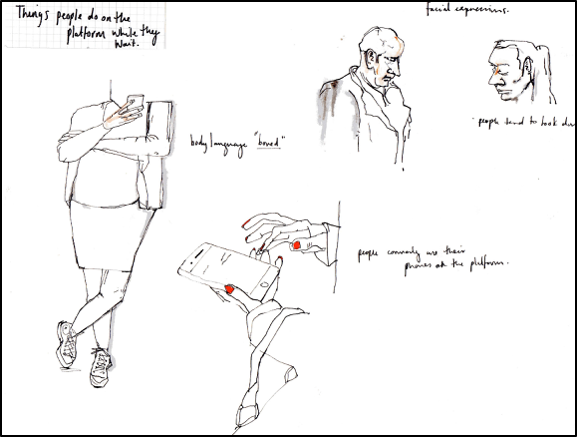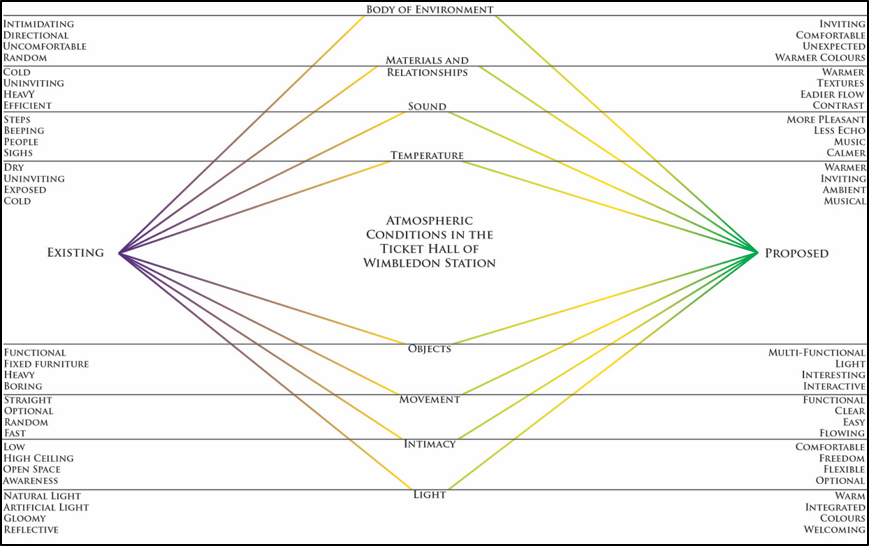
Valerie Mace, Course Leader, BA (Hons) Spatial Design, London College of Communication
This case study advocates a phenomenological approach to site-specific documentation and evaluation, placing human psychological needs and lived experiences at the centre of spatial design education. The project, with 2nd year students from the BA (Hons) Spatial Design course at London College of Communication, delineates how primary research methods are introduced as a prelude to sensory driven design iterations. It showcases how a public space became a pedagogic environment for students to bridge the gap between studio practice and lived experiences through active learning. It also underlines how introducing practices informed by academic research enhances the students’ learning experience.
primary research, active learning, spatial design, sensory experiences
Primary research in spatial design includes site-specific studies that enable students to document spaces and the way people occupy them. The practice requires students to be fully immersed in the site for a significant period of time, to observe, record and understand. Learning is experiential but the live dimension brings a level of complexity that can prove difficult to manage. Students may find it a daunting task, not knowing where to start and what to include. The process works best when structured using a clear methodology. Commonly used techniques derive from architectural practices, often with a known bias towards the visual. Knueppel explains that interior architects are proficient orchestrators of the visual realm, ‘including compositions of shapes, materials, textures, colour and lighting’ (2011, p.82). She concedes that design considerations may also include haptic qualities and acoustics, thus establishing an important link to other senses, but implies that the process is incomplete and that these qualities ‘seem to end up as a mere by-product of spatial compositions that have been conceived predominantly through visual means’ (2011, p.82). This endemic hegemony of the visual is well documented in architectural literature, with Pallasmaa leading the debate (2005).
Students on the BA (Hons) Spatial Design course at London College of Communication learn from the outset that space is not simply a conceived entity designed to look good but a perceived, experienced and active environment. Gibson articulates the context of environmental experiences through the ecological lens, highlighting the interrelationship between perceptions and behaviour, and reminding us that we are sentient beings living in-the-world (1986). Environmental experiences are difficult to capture using ocular-centric primary research methods. As a result, a new set of methods was required when 2nd year spatial design students were asked to reconsider how people experience the transition spaces at Wimbledon train station, as part of a brief asking them to provide sensory driven spatial design solutions that enrich commuters’ experience. I introduced into the curriculum a methodology and toolkit developed in my own academic research practice (Mace, 2014). For instance, one of the tools is ‘the sensory slider’ (Figure 1), which supports the documentation and evaluation of sensory stimuli within a site. It records the intensity of perceptions at a specific time and location, and enables the researcher to compare different areas within a site, while adding a temporal dimension to the study. By bringing academic research into teaching, the project enabled students to learn new modes of enquiring into sensory and perceptual phenomena.

Students were introduced to the project and methods in the studio. This studio-based introduction helped them develop a mind-set that supported a deeper engagement with the site study. The foundation of the sensory slider methodology originates from a theoretical perspective, which is used to underpin a practice-based primary research process. From the writings of Zumthor (2003), Malnar and Vodvarka (2004), Pallasmaa (2005) and Gibson (1983) students learnt about atmosphere in architecture, phenomenology, sensory perceptions and environmental conditions. Working within a public site also brings the ethical dimensions of research to the fore and students were introduced to key guiding principles on respecting other people in that space. Finally, students were organised into small working groups, provided with a clear schedule of visits over a 2-week period and briefed on essential health and safety requirements. Working on-site made the context and structure of the research explicit, while working collaboratively fostered a deeper approach to each task.
Each student used different methods to develop their projects, for example Sarah Bakieh used photography to document the site’s occupancy and levels of interactions (see Figure 2), while Joy Williams chose drawing as a means to record more intimate actions (see Figure 3).


Students developed their project across 4 interconnected stages: Discover, Define, Develop and Deliver. The stages were based on the double-diamond design process model instigated by the Design Council (2007). The final two ‐ ‘Develop’ and ‘Deliver’ ‐ relate to design processes that take place off-site once the primary research is completed and therefore are not explored in this study. Here, the focus is on the first two stages, ‘Discover’ and ‘Define’, which involve site documentation and evaluation. In addition, the process was further structured across three clusters of investigation: the physical site (the interior architecture), the active site (occupancy and movement) and the perceived site (sensory experiences and atmospheric qualities). The first two clusters are already common practices in spatial design education, however, the ‘perceived site’ is generally less documented. Using phenomenological tools such as the sensory slider, students were able to explore new ways to capture the multi-sensory environment and its elusive qualities. Ashleigh Nutton, for instance, used a method inspired by Gibson’s classification of sensory systems (1983) to record her journey through the site, across a range of sensory perspectives: visual, auditory, taste-smell, basic-orienting, haptic, kinaesthesia, temperature-humidity and time perception. She concluded that:
when you first go to a space, you do focus on the visual elements. Not often do you realise what you can smell, what you can hear. When you have multi-sensory designs, the visual is aesthetically pleasing […], but if you put it in a space where you have unpleasant noises, it changes the impact of your design. (Ashleigh Nutton in Inhabiting the Transition Space, 2015)
Other students such, as Sarah Bakieh, also found the noise levels to be a significant aspect of the spatial environment. Her research findings showed that the station is a bustling and noisy environment with significant increases in noise levels at peak times. The soundscape consists of background sounds such as the sounds of footsteps and voices of the crowds moving through the station and traffic noise outside the station. These are intermittently overpowered by loud announcements made through the station’s speaker system, while the sound of trains arriving and departing is unique to the site and contributes to behavioural clues.

Students also learnt to visualise their research findings in order to evaluate existing spatial atmospheric conditions and the effect of the environment on people. Visualising the data enabled them to make sense of the primary research documentation they had accumulated on site, see connections, make comparisons and draw conclusions. Kamila Rataj, who explored levels of participation within the site by considering how people interact with the site and with each other, realised that ‘it’s not just about the visual aspects of the design, people have to feel comfortable […] for the design to be successful’ (Kamila Rataj in Inhabiting the Transition Space, 2015). By ‘comfortable’, she suggests that the space needs to resonate with people on a psychological level. Her research provided a critical insight into our interrelationship with space, not only in terms of the way we feel about spaces but also the way spaces make us feel about ourselves and each other.

The final evaluative process required students to translate the knowledge they acquired about the site into a set of existing atmospheric conditions. The process of translation enabled them to more easily identify problems in the environment and understand where sensory transformations would benefit people. In representing existing atmospheric conditions, students were able to propose a new set of desired atmospheric conditions, which formed the basis of their design iterations, and presented their study to the group.

The complete project ‐ including all 4 stages of the design process and student presentations ‐ was compiled into a 5-minute documentary entitled Inhabiting the Transition Space (LCC, 2015), which was presented at UAL’s ‘Learning and Teaching Day 2016: Reimagining Creative Spaces for Teaching and Learning’ (Mace, 2016).
This project brought a rewarding live and active dimension to studio practice by enabling students to engage directly with people’s experiences in a pedagogically managed situation, while developing their spatial design research skills and subject knowledge from a phenomenological perspective. Student responses to the new research methods were very positive. They presented insightful evaluations that evidenced an in-depth knowledge of the site’s sensory characteristics and its occupants. Through this project they learnt how to carry out a holistic documentation of tangible and intangible attributes in spaces, challenging the reductive notion of body and space separation. Finally, they learnt how to use visualisation techniques to explicate and analyse their research and in doing so, developed a heightened sensitivity to spatial qualities and human psychological needs in the built environment.
Student work and comments are presented with full permission of the individuals concerned.
Design Council (2007) Eleven lessons: managing design in eleven global brands, a study of the design process. Available from: http://www.designcouncil.org.uk/sites/default/files/asset/document/ElevenLessons_Design_Council%20(2).pdf (Accessed: 11 June 2016).
Gibson, J.J. (1986) The ecological approach to visual perception. Rev. Edn. Hove: Taylor & Francis Group.
Gibson, J.J. (1983) The senses considered as perceptual systems. Rev. Edn. Santa Barbara: Praeger.
Knueppel, G. (2011) ‘Interspace: spatial and temporary formation of sensory communities within interior environments’ in Fleming, J et al (eds.) Interior tools, interior tactics: debates in interior theory and practice. Faringdon, Oxfordshire: Libri Publishing. pp. 81-92.
Mace, V. (2016) ‘The primary research learning experience: documenting life in spatial design’, Learning and Teaching Day 2016: reimagining creative spaces for teaching and learning. University of the Arts London, 13 January. Available at: http://cltad-web.arts.ac.uk/latd/2016/sessions/mace/ (Accessed: 28 June 2016).
Mace, V. (2014) ‘Sensing the urban interior’, [in]arch international conference: interiority and architecture, Universitas Indonesia, Depok, Jakarta, 10-12 September. Available from: http://ualresearchonline.arts.ac.uk/8427/ (Accessed: 12 June 2016).
Malnar, J.M. and Vodvarka, F. (2004) Sensory design. Minneapolis: University of Minnesota Press.
Pallasmaa, J. (2005) The eyes of the skin: architecture and the senses. Chichester, West Sussex: Wiley and Sons.
University of the Arts London / LCC, BA (Hons) Spatial Design (2015) Inhabiting the transition space: enriching Wimbledon commuters’ experience through spatial design. Available from: https://vimeo.com/148009029 (Accessed: 12th June 2016).
Zumthor, P. (2003) Atmospheres: architectural environments - surrounding objects. Basel: Birkhäuser.
Valerie Mace is Course Leader of BA (Hons) Spatial Design at London College of Communication. Valerie has extensive experience in curriculum developments for spatial design practices. She also initiates collaborations with external partners and develops international partnerships for the course. Valerie's research centres on place experience, sensing and atmosphere.